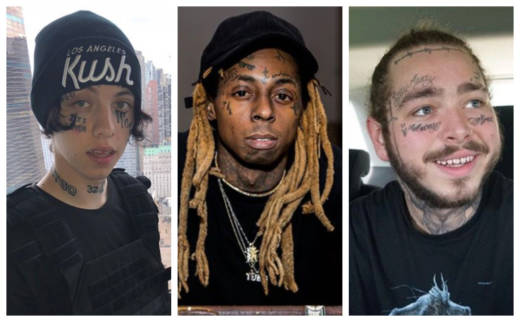In tattoo culture, there's a term for ink that's impossible to hide. Tattoos on the hands, neck or face are called "job stoppers," distinguished for their inescapable life consequences. And it's not just countless professions that discriminate against people with these kinds of tattoos; there's a good chance random strangers in your everyday life will treat you differently if you have them, too.
These days, more and more hip-hop stars are sporting them though. It started with Lil Wayne, Gucci Mane, Wiz Khalifa and The Game, but these days, face tattoos have gone next level thanks to the likes of Post Malone, XXXTentacion, Offset, Lil Peep, Lil Xan, Tekashi 6ix9ine and Arnoldisdead (who literally has an Anne Frank portrait tattooed on his right cheek).

It's quite a development given that face tatts are the ones treated with most caution by tattoo artists. Professional tattooists are generally wary of giving job stoppers to people who aren't already sufficiently inked elsewhere.
In 2015, after New York artist, Dan Bythewood came under fire for refusing to tattoo a Jezebel writer's neck, he hit back, saying: "As all tattooers know, a neck or hand tattoo is ... traditionally reserved for those heavily covered … I myself am still collecting tattoos, and do not have hand or neck tattoos yet. I have been tattooing for eight years and will consider getting both hands done after 10 years of service. Why? I take this ancient art form seriously. I take my craft seriously. I take the time-honored traditions of tattooing seriously. Traditions and respect that we are losing daily to a new petulant culture screaming 'gimme now!'"
With that in mind, it's difficult to fathom how Lil Xan found someone to ink his face, hands and neck, when his arms and chest are almost untouched, or how Post Malone managed to find an artist willing to put his very first tattoo—a Playboy bunny—under his right eye.


